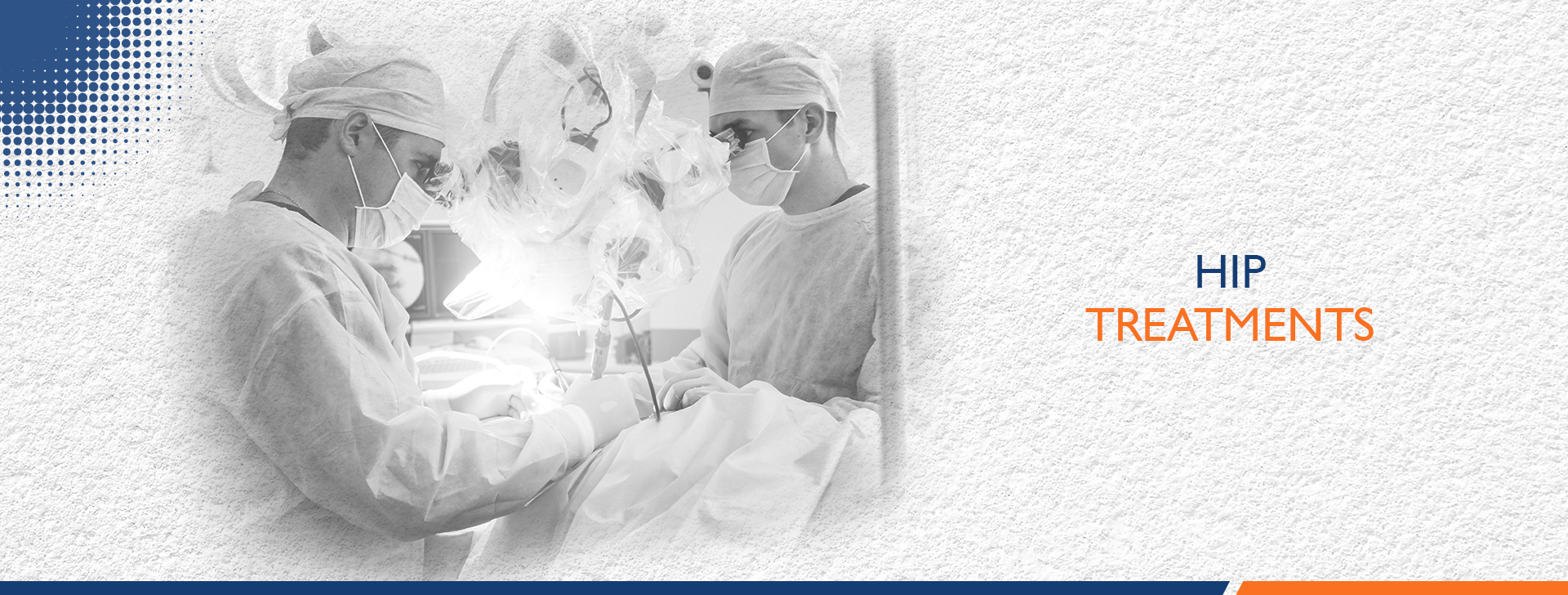The hip joint is a Diarthrodial Joint whose unique anatomy enables it to be both extremely strong and amazingly flexible, so it can bear weight and allow for a wide range of movements. The primary function of the hip joint is to provide dynamic support the weight of the body/trunk while facilitating force and load transmission from the axial skeleton to the lower extremities, allowing for ambulatory and mobility functions The hip is located where the head of the femur, or thighbone, fits into a rounded socket (Acetabulum) of the pelvis.
This ball-and-socket construction allows for three distinct types of flexibility:
- moving the leg back and forth;
- moving the leg out to the side (abduction) and inward toward the other leg (adduction)
- pointing toes inward (internal rotation) or outward (external rotation) and then moving the straightened leg in the direction of the toes.
Hip joint though very strong, but not indestructible. There are several reasons that may cause hip pain and damage:
- Arthritis. Osteoarthritis and rheumatoid arthritis are among the most common causes of hip, stiffness and have reduced range of motion in the hip., especially in older adults.
- Hip fractures. With age, the bones can become weak and brittle and are more likely to break during a fall.
- Bursitis: Inflammation of bursae is usually due to repetitive activities that overwork or irritate the hip joint which leads to hip joint pain
- Tendinitis: Inflammation or irritation of the tendons usually caused by repetitive stress from overuse.
- Hip labral tear: Athletes and people who perform repetitive twisting movements are at higher risk of developing this problem.
- Avascular necrosis (also called osteonecrosis). This condition happens when blood flow to the hip bone slows and the bone tissue dies. It can be caused by a hip fracture or dislocation, or from the long-term use of high-dose steroids (such as prednisone), among other causes.
Types Of Treatments
Hip Arthroscopy
Hip arthroscopy is a minimally invasive form of hip surgery in which an orthopedic surgeon creates access points for arthroscopic needles, scalpels or other special surgical tools to examine or treat the inside of the hip joint and surrounding soft tissues. During the procedure, a small camera called an arthroscope is inserted into your hip joint through small incisions, usually about 1 cm, thereby avoiding large cuts as compared to a conventional open surgery. The camera is connected to a video monitor that relays the detailed pictures of the hip joint. The surgeon can now directly observe the inside of the joint, evaluate numerous key anatomic structures and helps verify the safe placement of other specialized instruments. This exploratory surgery allows the hip replacement surgeon to diagnose the cause of hip pain or other joint problems that is creating discomfort for the patient.
Hip Arthroscopy may be recommended for hip conditions that do not respond to non-surgical treatment. Hip arthroscopy may be recommended as treatment for the following conditions.
- Hip impingement (femoroacetabular impingement)
- Labral Tears
- Removal of loose fragments of cartilage inside the hip joint
Limitations:
Hip Arthroscopy is case dependent and if the extent of damage is more, then its outcomes are doubtful therefore proper planning with the help of investigations, X rays and MRI is mandatory.
HIP Replacement Surgery
A total hip replacement is a surgical procedure whereby the diseased cartilage and bone of the hip joint is surgically replaced to relieve the patient of hip is discomfort. If the hip has been damaged by arthritis, a fracture, or because of heavy impact; performing regular activities may become painful and difficult. One will find stiffness in the hip, and discomfort while walking, or bending and perhaps even while resting. Hip replacement surgery is commonly advised when:
- Hip pain that limits everyday activities and impairs overall quality of life, such as walking or bending
- Hip pain that continues while resting, either day or night
- Stiffness in a hip that limits the ability to move or lift the leg
- Inadequate pain relief from anti-inflammatory drugs, physical therapy, or walking supports
Total hip replacements are performed most commonly because of:
- Progressively worsening of severe arthritis in the hip joint. The most common type of arthritis leading to total hip replacement is osteoarthritis of the hip joint. The most common cause of chronic hip pain and disability is arthritis. Osteoarthritis, rheumatoid arthritis, and traumatic arthritis are the most common forms of this disease
- Avascular necrosis (Osteonecrosis)
- Childhood hip disease
In Hip Replacement Surgery, the surgeon removes the damaged sections of your hip joint and replaces them with parts usually constructed of metal, ceramic and very hard plastic. This artificial joint or prosthesis helps reduce pain and improve function. The prosthetic components could either be ‘press fit’ into the bone or they may be cemented into place. Based on a number of factors, such as the quality and strength of your bone, the orthopedic surgeon will decide to press fit or to cement the components or use a combination of both.
BIPOLAR HEMIARTHROPLASTY
Treatment for femoral neck fractures can be successfully achieved through a bipolar hemiarthroplasty. Fractures of the hip often occur within the femoral neck, a thin section of the thigh bone that helps to connect the “ball” end of the bone to the main shaft. When a fracture occurs in this area of the bone, it can cut off blood supply and lead to severe joint damage that cannot be treated with conservative methods.
Hemiarthroplasty is a surgical procedure that replaces one half of the hip joint with a prosthetic, while leaving the other half intact whereas in hip replacement surgery both the components of joint are replaced. During the hemiarthroplasty procedure, the damaged femoral head and neck are removed and replaced with the bipolar prosthetic. The prosthetic may be held in place with or without cement. Patients will need to undergo physical therapy after surgery to help restore movement and function to the joint. Therapy begins post surgery often the very next day. Most patients experience effective, long-term results from this procedure.
Our Team
-
Dr. Narendra Vaidya
Dr. Narendra Vaidya is an internationally acclaimed Joint Replacement Surgeon providing expert consultations and surgical expertise in many countries. A leading Adult Reconstructive Surgeon, he has successfully performed 8000+ Joint Replacement surgeries and more than 50,000+ Orthopaedic Surgeries in India and abroad.
Lokmanya Advantages:
- High End Technology proven in developed Western markets made accessible to masses
- Earmarked Institutional Practice
- Superior Surgical Outcomes
- Internationally Trained Young & Dynamic Team of Orthopedic & Spine Surgeons
- An experienced & committed Management Team
- Direct Community Connect
- 360 degree approach from Awareness, Prevention to Treatment & Rehabilitation
Our Locations
Lokmanya Hospitals – Nigdi
Sector 27, Lokmanya Tilak Road,
Pradhikaran, Nigdi.
Locate Us
Lokmanya Hospitals – Chinchwad
314 / B, Chinchwad Gaon Road.
Pune – 411033
Locate Us
Lokmanya Hospitals – Swargate
Lokmanya Hospital Pvt. Ltd 484/6,
Mitramandal Colony Araneshwar road,
Parvati, Pune 411 009.
Locate Us
Lokmanya Hospitals – Aundh
163, Dp Road, Near Dav School
Aundh, Pune-4106001
Locate Us
Lokmanyas Hospitals – Kolhapur
328 E,Roy Phase Dhabolkar Corner
New Shahupuri,Kolhapur-4106001
Locate Us
Lokmanya Hospital – SB Road
Lokmanya Hospital for Superspeciality Surgery
402/A Gokhale Nagar Road Off Senapati Bapat Marg, Vetal Baba Chowk, Maharashtra 411016
Locate Us











